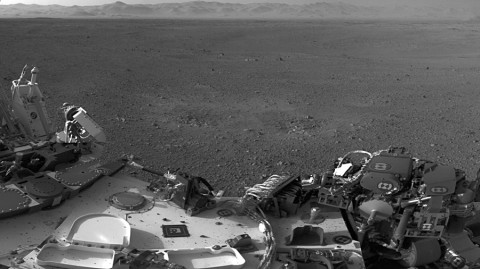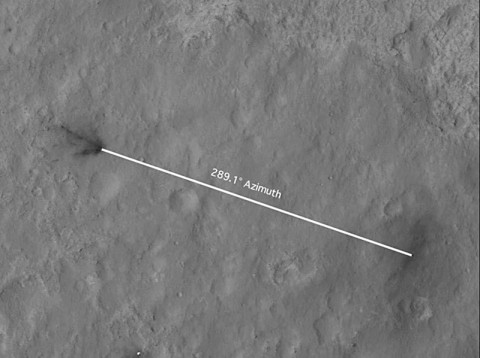Written by Guy Webster and D.C. Agle
NASA’s Jet Propulsion Laboratory
 Pasadena, CA – NASA’s Mars rover Curiosity will spend its first weekend on Mars transitioning to software better suited for tasks ahead, such as driving and using its strong robotic arm.
Pasadena, CA – NASA’s Mars rover Curiosity will spend its first weekend on Mars transitioning to software better suited for tasks ahead, such as driving and using its strong robotic arm.
The rover’s “brain transplant,” which will occur during a series of steps August 10th through August 13th, will install a new version of software on both of the rover’s redundant main computers. This software for Mars surface operations was uploaded to the rover’s memory during the Mars Science Laboratory spacecraft’s flight from Earth.

A key capability in the new version is image processing to check for obstacles. This allows for longer drives by giving the rover more autonomy to identify and avoid potential hazards and drive along a safe path the rover identifies for itself. Other new capabilities facilitate use of the tools at the end of the rover’s robotic arm.

While Curiosity is completing the software transition, the mission’s science team is continuing to analyze images the rover has taken of its surroundings inside Gale Crater. Researchers are discussing which features in the scene to investigate after a few weeks of initial checkouts and observations to assess equipment on the rover and characteristics of the landing site.
The Mars Science Laboratory spacecraft delivered Curiosity to its target area on Mars at 10:31:45pm PDT on August 5th (12:31:45am CDT on August 6th), which includes the 13.8 minutes needed for confirmation of the touchdown to be radioed to Earth at the speed of light.
Curiosity carries 10 science instruments with a total mass 15 times as large as the science payloads on NASA’s Mars rovers Spirit and Opportunity. Some of the tools, such as a laser-firing instrument for checking rocks’ elemental composition from a distance, are the first of their kind on Mars. Curiosity will use a drill and scoop, which are located at the end of its robotic arm, to gather soil and powdered samples of rock interiors, then sieve and parcel out these samples into the rover’s analytical laboratory instruments.To handle this science toolkit, Curiosity is twice as long and five times as heavy as Spirit or Opportunity. The Gale Crater landing site at 4.59 degrees south, 137.44 degrees east, places the rover within driving distance of layers of the crater’s interior mountain. Observations from orbit have identified clay and sulfate minerals in the lower layers, indicating a wet history.
Mars Science Laboratory is a project of NASA’s Science Mission Directorate. The mission is managed by JPL. Curiosity was designed, developed and assembled at JPL, a division of the California Institute of Technology in Pasadena.
For more about NASA’s Curiosity mission, visit: http://www.jpl.nasa.gov/msl
http://www.nasa.gov/mars and http://marsprogram.jpl.nasa.gov/msl .
Follow the mission on Facebook and Twitter at: http://www.facebook.com/marscuriosity
and http://www.twitter.com/marscuriosity .


